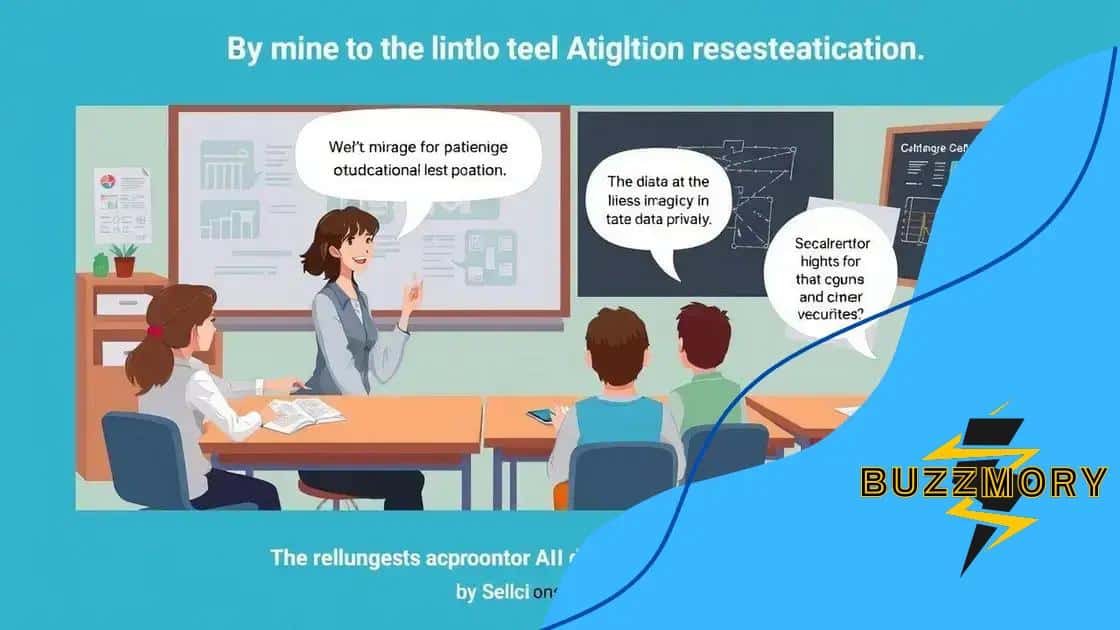The role of AI in grading and assessment automation

The role of AI in grading and assessment automation significantly enhances educational efficiency by providing personalized learning experiences, automating grading, and ensuring consistent feedback for students.
The role of AI in grading and assessment automation is becoming increasingly important in education. Imagine how much easier life could be for educators. Wouldn’t it be nice to spend less time on grading and more on interacting with students?
Understanding AI in education
Understanding AI in education is essential for teachers and students alike. As technology evolves, it’s important to grasp how AI can enhance learning experiences. It has the potential to tailor education to individual needs, making lessons more effective.
What is AI?
Artificial Intelligence, or AI, refers to the simulation of human intelligence in machines. These systems can perform tasks that typically require human-like thinking, such as learning and problem-solving. In education, AI can analyze student data to provide personalized recommendations.
How AI Benefits Education
AI technology can transform the traditional classroom setting. By automating repetitive tasks, teachers can focus more on interactive lessons. With AI, educators receive valuable insights into student performance. Here are a few ways AI benefits education:
- Personalized Learning: AI systems adapt lessons to fit each student’s learning pace.
- Efficient Grading: Automated grading reduces the workload for teachers, allowing them to spend time on teaching.
- Real-time Feedback: Students receive instant feedback from AI tools, helping them understand their mistakes and learn.
Another fascinating aspect of AI in education is its ability to identify learning patterns. By analyzing data, AI can spot areas where a student struggles and recommend resources to help them improve. With tools like chatbots, students can even get assistance outside classroom hours, making education more accessible.
As we delve deeper into the role of AI in assessments, it’s clear that technology is bridging the gap between educators and students. Adapting to these changes can lead to more engaging and effective learning experiences.
Benefits of automated grading systems
The benefits of automated grading systems are becoming increasingly clear in modern education. These systems can help both teachers and students achieve better outcomes, allowing for a more efficient learning environment. Imagine being able to reduce the time spent on grading, while also increasing the accuracy of assessments.
Time-Saving Advantages
One of the most prominent benefits is that automated grading saves time. Teachers can focus on what truly matters – engaging with their students. Instead of spending hours grading papers, they can invest that time into creating dynamic lessons or providing personalized support.
Improved Accuracy
Automated systems also enhance the accuracy of grading. By eliminating human error, these tools ensure fair evaluations. Key advantages include:
- Consistency: Machines apply the same criteria every time, resulting in uniform grading.
- Immediate Feedback: Students receive instant results, enabling them to understand their mistakes right away.
- Data Analysis: Automated tools can track student performance over time to identify trends and areas for improvement.
Using automated grading systems fosters a better learning experience by providing immediate insights. Educators can adjust their methods based on performance data, ensuring that students are always getting the best education possible. These systems also lessen the pressure on teachers by providing additional support.
As we explore the advantages of integrating automation into the grading process, it’s evident that the impact on education can be profoundly positive. Embracing this technology can pave the way for a more productive classroom atmosphere, benefiting everyone involved.
Challenges of AI in assessments

The challenges of AI in assessments highlight the complexities and potential pitfalls of implementing artificial intelligence in education. While AI offers exciting possibilities, it is essential to address these challenges to ensure effective integration in the learning environment.
Data Privacy Concerns
One significant challenge is maintaining data privacy. Schools must protect sensitive student information while using AI tools. Ensuring compliance with regulations such as FERPA is crucial. Educators need to be transparent about how data is collected and used.
Bias in Algorithms
Another concern is the potential for bias in AI algorithms. If the data used to train these systems is not diverse, it can lead to unfair assessments. Important aspects to consider include:
- Equity: AI systems must provide equal opportunities for all students.
- Transparency: Understanding how decisions are made by AI tools is essential for trust.
- Continuous Monitoring: Regularly checking AI systems for bias ensures fairness in assessments.
Moreover, the reliance on technology can sometimes overshadow the value of human interaction. Teachers play a vital role in understanding students beyond just numbers and grades. Automated systems cannot fully replace the personalized support that educators provide. While integrating AI can enhance efficiency, it is important to maintain a balance.
As we evaluate the role of AI in assessments, it’s clear that while this technology can offer significant benefits, addressing these challenges is essential for successful implementation. Educators need to guide the integration of AI thoughtfully to maximize its potential.
Future trends in grading technology
The future trends in grading technology are paving the way for significant improvements in how assessments are conducted. As educational technology advances, new methods are emerging that promise to make grading more efficient and useful for both teachers and students.
Integration of AI and Machine Learning
One major trend is the integration of artificial intelligence and machine learning into grading systems. These technologies can analyze vast amounts of data to provide insights into student performance. For example, AI can identify patterns in student responses, highlighting areas where they struggle. This allows educators to tailor their teaching to meet individual needs.
Enhanced Analytics
Furthermore, there will be a focus on enhanced analytics capabilities in grading technology. Educators will gain access to more sophisticated data about student progress. Key benefits include:
- Real-Time Insights: Teachers can receive immediate feedback on assessments, letting them adjust lessons quickly.
- Predictive Analytics: Schools can anticipate which students may need additional support based on trends identified in data.
- Comparative Analysis: Comparing performance across different classes or subjects to improve overall teaching strategies.
As new technologies emerge, we may also see more personalized assessments. Instead of one-size-fits-all tests, educators could create evaluations tailored to each student’s learning style. This not only improves engagement but also provides a more accurate measure of understanding.
Finally, automation will play a crucial role in reducing the time teachers spend on grading. With advances in technology, tools will streamline the grading process and help educators focus more on teaching. As these trends develop, the educational landscape will transform, making learning more effective and enjoyable.
Implementing AI tools in classrooms
Implementing AI tools in classrooms can greatly enhance educational experiences for both teachers and students. As technology advances, schools are discovering innovative ways to use artificial intelligence to improve learning outcomes.
Types of AI Tools
Various types of AI tools are available for educators. Some of the most popular include:
- Adaptive Learning Platforms: These platforms adjust the curriculum based on individual student performance, offering personalized learning paths.
- AI Tutors: Virtual tutors can provide extra help to students, answering questions and guiding them through challenging material.
- Assessment Tools: AI systems that grade assignments and tests help educators save time and provide consistent feedback.
Adopting these tools can lead to a more engaging classroom environment. For instance, when students use adaptive learning platforms, they feel more in control of their learning. They can progress at their own pace, which often leads to better understanding and retention of knowledge.
Challenges in Implementation
While AI tools offer remarkable benefits, there are also challenges to consider. Schools need to be mindful of data privacy issues, ensuring that student information is securely protected. Additionally, teacher training is crucial for effectively using AI tools. Educators must feel confident in integrating technology into their teaching.
Incorporating AI tools requires thoughtful planning. Schools should invest in training programs for teachers and secure reliable AI resources. As educators embrace this technology, they can create a more engaging and personalized experience for every student.
In conclusion, implementing AI tools in classrooms brings significant advantages, such as personalized learning and efficient grading. However, schools must also address challenges like data privacy and proper teacher training. With thoughtful integration of these technologies, educators can enhance the learning experience and create more engaging environments for students. Future trends show promise, indicating that AI will play a vital role in shaping education. By embracing these changes, we can foster greater educational outcomes and support every learner’s unique journey.
FAQ – Frequently Asked Questions about AI in Education
What are the main benefits of using AI tools in classrooms?
AI tools provide personalized learning experiences, save time for teachers through automation, and enhance student engagement.
How can AI help with grading?
AI can automate the grading process, ensuring consistency and immediate feedback for students, which helps them understand their performance better.
What challenges come with implementing AI in education?
Challenges include data privacy concerns, the need for proper teacher training, and ensuring that AI tools are used fairly and equitably.
What future trends can we expect in educational AI?
Future trends may include more advanced analytics, greater personalization of learning experiences, and continued improvements in automation to enhance efficiency.





